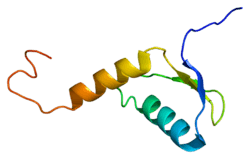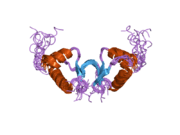GTF2H5
| View/Edit Human | View/Edit Mouse |
General transcription factor IIH subunit 5 is a protein that in humans is encoded by the GTF2H5 gene.[3][4]
Interactions
GTF2H5 has been shown to interact with GTF2H2[3][5] and XPB.[3]
References
- ↑ "Human PubMed Reference:".
- ↑ "Mouse PubMed Reference:".
- 1 2 3 Giglia-Mari G, Coin F, Ranish JA, Hoogstraten D, Theil A, Wijgers N, Jaspers NG, Raams A, Argentini M, van der Spek PJ, Botta E, Stefanini M, Egly JM, Aebersold R, Hoeijmakers JH, Vermeulen W (June 2004). "A new, tenth subunit of TFIIH is responsible for the DNA repair syndrome trichothiodystrophy group A". Nat. Genet. 36 (7): 714–9. doi:10.1038/ng1387. PMID 15220921.
- ↑ "Entrez Gene: GTF2H5 general transcription factor IIH, polypeptide 5".
- ↑ Vermeulen W, Bergmann E, Auriol J, Rademakers S, Frit P, Appeldoorn E, Hoeijmakers JH, Egly JM (November 2000). "Sublimiting concentration of TFIIH transcription/DNA repair factor causes TTD-A trichothiodystrophy disorder". Nat. Genet. 26 (3): 307–13. doi:10.1038/81603. PMID 11062469.
Further reading
- Vermeulen W, Bergmann E, Auriol J, Rademakers S, Frit P, Appeldoorn E, Hoeijmakers JH, Egly JM (2000). "Sublimiting concentration of TFIIH transcription/DNA repair factor causes TTD-A trichothiodystrophy disorder". Nat. Genet. 26 (3): 307–13. doi:10.1038/81603. PMID 11062469.
- Coin F, Proietti De Santis L, Nardo T, Zlobinskaya O, Stefanini M, Egly JM (2006). "p8/TTD-A as a repair-specific TFIIH subunit". Mol. Cell. 21 (2): 215–26. doi:10.1016/j.molcel.2005.10.024. PMID 16427011.
- Giglia-Mari G, Miquel C, Theil AF, Mari PO, Hoogstraten D, Ng JM, Dinant C, Hoeijmakers JH, Vermeulen W (2006). "Dynamic interaction of TTDA with TFIIH is stabilized by nucleotide excision repair in living cells". PLoS Biol. 4 (6): e156. doi:10.1371/journal.pbio.0040156. PMC 1457016
 . PMID 16669699.
. PMID 16669699. - Vitorino M, Coin F, Zlobinskaya O, Atkinson RA, Moras D, Egly JM, Poterszman A, Kieffer B (2007). "Solution structure and self-association properties of the p8 TFIIH subunit responsible for trichothiodystrophy". J. Mol. Biol. 368 (2): 473–80. doi:10.1016/j.jmb.2007.02.020. PMID 17350038.
This article is issued from Wikipedia - version of the 5/20/2016. The text is available under the Creative Commons Attribution/Share Alike but additional terms may apply for the media files.



